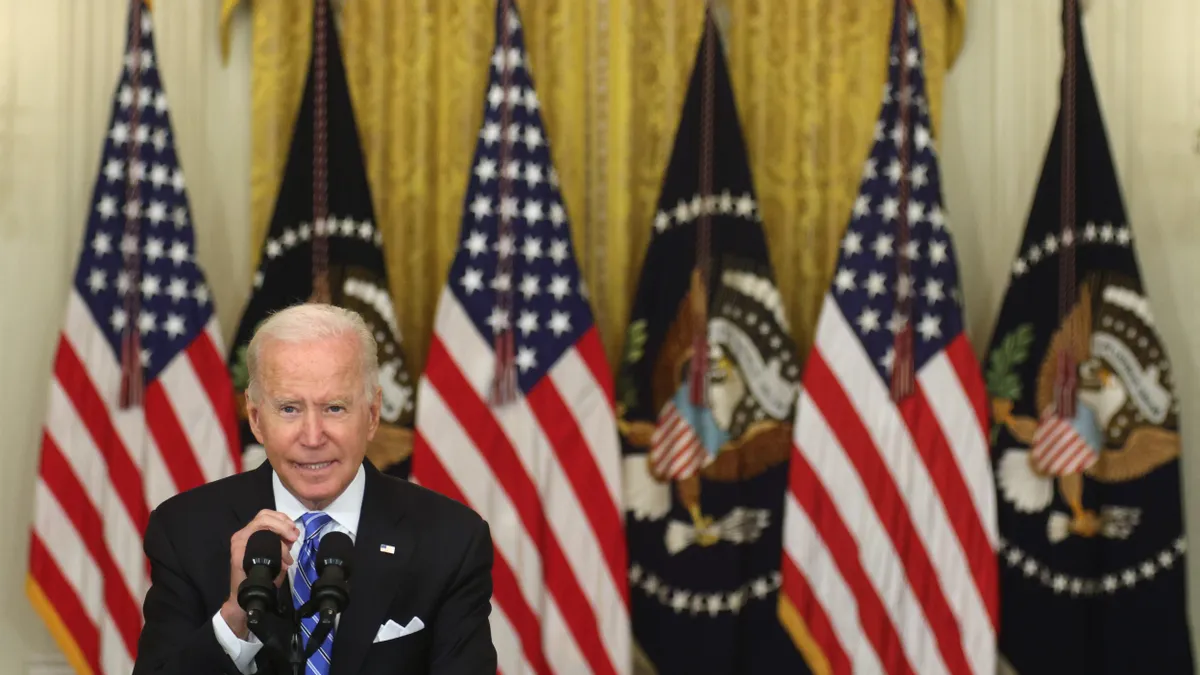Systemic discrimination and the civil rights consequences of the COVID-19 pandemic are "on the front burner" for the U.S. Equal Employment Opportunity Commission going into the final part of 2021, EEOC Chair Charlotte Burrows told attendees during the Society for Human Resource Management's 2021 annual conference Sept. 9.
But in their questions to Burrows and Commissioner Keith Sonderling, HR professionals were quick to bring up COVID-19 vaccination mandates.
The pair were first asked about exemptions for individuals who cite a sincerely-held religious belief that would prevent them from receiving a COVID-19 vaccine.
Both began their responses by reminding attendees about the EEOC's federal purview and the potential impact of state and local laws on vaccine mandates. Beyond that, the commissioners avoided specifics and made clear they were not going to offer legal advice.
"I would just say to think about it simply," said Burrows. "The federal law is a floor, not a ceiling. So civil rights at the state level can be more protective, but they can't be less protective than the level that the federal [law] sits."
Soon after, an audience member asked about the challenge of ensuring equity in vaccine mandates, given the disparity of COVID-19 vaccination between racial and ethnic groups.
Burrows said employers need to note the fact-specific nature of such challenges. "Regardless if you're in Iowa, Texas, Florida or anywhere else in the country, the question is looking at the reasons why," she continued. "Some of it may be just asking your workforce […] just trying to figure out what barriers there are."
Accessibility to vaccines has improved since the beginning of the U.S. vaccine roll-out, but employers may need to rely on a mix of education and incentives moving forward, and that combination may not look the same for all employers, Burrows said; "I don't think it's one-size-fits-all."
In May, EEOC published a technical assistance document outlining the conditions under which employers may need to engage in an interactive process with employees who are eligible for reasonable accommodations, specifically exemptions from vaccination mandates.
Under Title VII of the 1964 Civil Rights Act, those with a sincerely-held religious belief, practice or observance that would prevent them from getting vaccinated fall under that definition, though accommodations would need to avoid posing an undue hardship on the operation of the employer's business, per EEOC.
The agency anticipates publishing additional guidance through the fall, Burrows said, and that could potentially include information about whether "long COVID," also referred to by the Centers for Disease Control and Prevention as "long-haul COVID" or "post-acute COVID," among other names, qualifies as a disability under the Americans with Disabilities Act.
On that subject, Burrows pointed to guidance from other federal agencies, including the U.S. Department of Health and Human Services and the Department of Justice. HHS' guidance, in particular, has said that long COVID is considered a disability under the ADA if it substantially limits one or more major life activities.
"We are constantly thinking about how ... we update the guidance that we have on our website," Burrows said of the technical assistance document. "It's not a static document because this has not been a static situation."
Pair of ADA questions draw crowd applause
One audience question came from a Texas disability program manager, who asked about the rise of remote work. Employees at his organization are realizing their potential savings on commutes and child care through remote work, leading to increased requests, he said. The manager said he estimated that "30%-35% of cases I adjudicate through the interactive process are manipulative or abusive or in some other way posed in bad faith."
The manager then asked if the EEOC was planning to provide guidance on how to deal with abusive practices in the ADA process. His question drew applause from the live audience.
"I'm not exactly sure which practices are considered abusive," Burrows said. "What I hear underlying that question is, this is a difficult thing."
The chair compared telework policies during the pandemic to sidewalk curb cuts; "we go up there whether we need the use of a mobility device or not. But the curb cuts are not for us, and it's similar to that for telework."
Burrows continued in saying that while federal law permits employers to avoid granting unreasonable accommodations, scenarios are not always clear-cut. "If it's convenient for someone but it's not in the employer's interest and there's not a disability-related reason, from our perspective and of the EEO laws, that's the end of the story," she said. "I think there are difficult issues on both sides and we see abuses on both sides."
Sonderling offered a similar answer, pointing to the importance of how the essential functions of an employee's job are defined. He added that the interactive process occurs on an individual employee basis, not for an entire division of the workforce.
A separate audience question, also drawing applause, sought information about the agency's position on an initiative to address fraudulent claims made by workers, particularly in the context of small businesses that may not have extensive resources or HR staff.
"I mean employees, when they do that, they have the right to file under our laws and they have to testify under oath that these claims are accurate," Sonderling said. "If you believe or your company believes that these are fraudulent position statements, tell the EEOC that in your position statement […] that process has been in existence since the 1960s and it's not going anywhere."
Burrows added that the agency does want to know when an employer suspects that employees' claims are fraudulent. "We have more than enough to do, so anything that you can point to to help us […] we're looking for the ones that have merit," she said. "We don't need to spend time on something that doesn't."
On diversity initiatives and EEO-1
EEO-1 reporting came up a couple of times during the panel, first in the context of pay data reporting. Burrows said the commission is "in the process of eagerly awaiting" the results of a National Academies of Science, Engineering and Medicine report analyzing the 2017 and 2018 calendar year pay data it collected from employers as part of EEO-1 Component 2.
She added that the organization will provide recommendations to EEOC that "hopefully will help inform our work in this area."
An audience member asked how employers can approach EEO-1 reporting for diversity categories that current editions of the forms may not cover. Burrows said that employers can voluntarily note in their EEO-1s that employees wish to identify, for example, as other genders that are not necessarily recorded and designated by EEO-1.
With respect to EEO-1 reporting and employees of multiple races, EEOC is "looking into trying to figure out how to do that in a way that reflects the growing diversity of the country but that is also still usable for us," Burrows added.


















